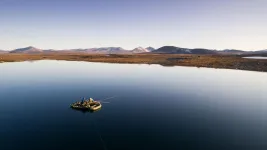A new view on plate tectonics
Nature study finds transform faults play active role in shaping ocean floors
2021-03-17
(Press-News.org) Forces acting inside the Earth have been constantly reshaping the continents and ocean basins over millions of years. What Alfred Wegener published as an idea in 1915 has finally been accepted since the 1960s, providing a unifying view about our planet. The fact that the theory of plate tectonics took so long to gain acceptance had two simple reasons. First, the geological formations that are most important for its understanding lie at the bottom of the oceans. Secondly, forces controlling the processes act below the seafloor and are hence hidden from our view. Many details of plate tectonics are therefore still unclear today.
Today, five scientists from GEOMAR Helmholtz Centre for Ocean Research Kiel, the Southern University of Science and Technology (Shenzhen, China) and GeoModelling Solutions GmbH (Switzerland) publish a study in the international scientific journal Nature that questions a previous basic assumption of plate tectonics. It is about so-called transform faults. "These are large offsets in the mid-ocean ridges. So far, they have been assigned a purely passive role within plate tectonics. However, our analyses show that they are definitely actively involved in shaping the ocean floors," explains Prof. Ingo Grevemeyer from GEOMAR, lead author of the study.
A look at a global overview map of the ocean floors helps to understand the study. Even at low resolution, several tens of thousands of kilometres long mid-ocean ridges can be recognised on such maps. They mark the boundaries of the Earth's plates. In between, hot material from the Earth's interior reaches the surface, cools down, forms new ocean floor and pushes the older ocean floor apart. "This is the engine that keeps the plates moving," explains Prof. Grevemeyer.
However, the mid-ocean ridges do not form unbroken lines. They are cut by transverse valleys at almost regular intervals. The individual segments of the ridges each begin or end in an offset at these incisions. "These are the transform faults. Because the Earth is a sphere, plate movements repeatedly cause faults that produce these ridge offsets," explains Prof. Lars Rüpke from GEOMAR, co-author of the study.
Earthquakes can occur at the transform faults and they leave long scars, so-called fracture zones, on oceanic plates. Until now, however, research assumed that the two plates only slide past each other at transform faults, but that seafloor is neither formed nor destroyed in the process.
The authors of the current study have now looked at available maps of 40 transform faults in all ocean basins. "In all examples, we could see that the transform valleys are significantly deeper than the adjacent fractures zones, which were previously thought to be simple continuations of the transform valleys," says co-author Prof. Colin Devey from GEOMAR. The team also detected traces of extensive magmatism at the outer corners of the intersections between transform valleys and the mid-ocean ridges.
Using sophisticated numerical models, the team found an explanation for the phenomenon. According to this, the plate boundary along the transform fault is increasingly tilted at depth, so that shearing occurs. This causes extension of the seafloor, forming the deep transform valleys. Magmatism at the outer corners to the mid-ocean ridges then fills up the valleys, so that the fracture zones become much shallower. Oceanic crust that forms at the corners is therefore the only crust in the ocean that is formed by two-stage volcanism. What effects this has on its composition or, for example, the distribution of metals in the crust is still unknown.
Since transform faults are a fundamental type of plate boundary and frequent phenomenon along active plate boundaries in the oceans, this new finding is an important addition to the theory of plate tectonics and thus to understanding our planet. "Actually, the observation was obvious. But there are simply not enough high-resolution maps of the seafloor yet, so no one has noticed it until now," says Prof. Grevemeyer.
INFORMATION:
ELSE PRESS RELEASES FROM THIS DATE:
2021-03-17
Tucson, Ariz. (March 16, 2021) - This week, a new, peer-reviewed scientific study finds that there is far more potential jaguar habitat in the U.S. than was previously thought. Scientists identified an area of more than 20 million acres that could support jaguars in the U.S., 27 times the size of designated critical habitat.
The results, published in the journal Oryx, are based on a review of 12 habitat models for jaguars within Arizona and New Mexico, conclusively identifying areas suitable for the recovery of these wild cats. Based on the expanded habitat area, the authors conclude that findings uncover new opportunities for jaguar conservation in North America that ...
2021-03-17
Researchers have channeled the universe's earliest light - a relic of the universe's formation known as the cosmic microwave background (CMB) - to solve a missing-matter mystery and learn new things about galaxy formation. Their work could also help us to better understand dark energy and test Einstein's theory of general relativity by providing new details about the rate at which galaxies are moving toward us or away from us.
Invisible dark matter and dark energy account for about 95% of the universe's total mass and energy, and the majority of the 5% that is considered ordinary matter is also largely unseen, such as the gases at the outskirts of galaxies that comprise their so-called halos.
Most ...
2021-03-17
Imagine not a white, but a green Arctic, with woody shrubs as far north as the Canadian coast of the Arctic Ocean. This is what the northernmost region of North America looked like about 125,000 years ago, during the last interglacial period, finds new research from the University of Colorado Boulder.
Researchers analyzed plant DNA more than 100,000 years old retrieved from lake sediment in the Arctic (the oldest DNA in lake sediment analyzed in a publication to date) and found evidence of a shrub native to northern Canadian ecosystems 250 miles (400 km) farther north than its current range.
As the Arctic warms much ...
2021-03-17
An estimated 14,480 new cases of invasive cervical cancer will be diagnosed in the United States this year, according to the American Cancer Society. Cases that could be prevented or cured with better education from screening to treatment based on improved provider-patient communication, says a Michigan State University researcher.
The issue is particularly acute for Black women, said Sabrina Ford, an associate professor in the Department of Obstetrics, Gynecology and Reproductive Biology within MSU's College of Human Medicine. Ford's research was published ...
2021-03-17
Artificial light at night (ALAN) is a major factor in global insect decline. In a paper published today in Insect Conservation and Diversity, Smithsonian Conservation Biology Institute (SCBI) scientists and partners found that using amber-colored filters to remove the blue spectra of light from "warm white" LED (light-emitting diode) lamps drastically reduces insect attraction to nocturnal lighting in a tropical forest. This is the first study to validate quantitative predictions of how lamp color affects insect attraction and provide clear recommendations to mitigate the negative impacts of ALAN on wildlife in rainforest ecosystems.
"While ...
2021-03-17
Many bacteria swim towards nutrients by rotating the helix-shaped flagella attached to their bodies. As they move, the cells can either 'run' in a straight line, or 'tumble' by varying the rotational directions of their flagella, causing their paths to randomly change course. Through a process named 'chemotaxis,' bacteria can decrease their rate of tumbling at higher concentrations of nutrients, while maintaining their swimming speeds. In more hospitable environments like the gut, this helps them to seek out nutrients more easily. However, in more nutrient-sparse ...
2021-03-17
A new study involving UCLA researchers finds that mobile stroke units (MSUs) - state-of-the-art ambulances built to provide stroke patients with emergency neurological diagnosis and treatment prior to hospital arrival -- improve patient outcomes and lessen the chance for disability by delivering care faster than standard stroke care.
The UCLA Mobile Stroke Unit serves as a shared regional resource of LA County EMS Provider Agencies, taking patients to 15 different stroke center hospitals within 3 regions in Los Angeles County. The MSU carries a CT scanner that can directly image the brain and blood vessels in the field. UCLA was one of seven national mobile stroke unit programs to participate in the clinical trial, which was presented March 17 at the ...
2021-03-17
Water is an ephemeral thing. It can emerge from an isolated spring, as if by magic, to birth a babbling brook. It can also course through a mighty river, seeping into the soil until all that remains downstream is a shady arroyo, the nearby trees offering the only hint of where the water has gone.
The interplay between surface water and groundwater is often overlooked by those who use this vital resource due to the difficulty of studying it. Assistant professors Scott Jasechko and Debra Perrone, of UC Santa Barbara, and their colleagues leveraged their enormous ...
2021-03-17
George Washington University researchers found low dose aspirin may reduce the need for mechanical ventilation, ICU admission and in-hospital mortality in hospitalized COVID-19 patients. Final results indicating the lung protective effects of aspirin were published today in Anesthesia & Analgesia.
"As we learned about the connection between blood clots and COVID-19, we knew that aspirin - used to prevent stroke and heart attack - could be important for COVID-19 patients," Jonathan Chow, MD, assistant professor of anesthesiology and critical care medicine and director of the Critical Care Anesthesiology ...
2021-03-17
A recent study shows that lettuce can be grown in greenhouses that filter out wavelengths of light used to generate solar power, demonstrating the feasibility of using see-through solar panels in greenhouses to generate electricity.
"We were a little surprised - there was no real reduction in plant growth or health," says Heike Sederoff, co-corresponding author of the study and a professor of plant biology at North Carolina State University. "It means the idea of integrating transparent solar cells into greenhouses can be done."
Because plants do not use all of the wavelengths of light for photosynthesis, researchers have explored the idea of creating semi-transparent organic solar ...
LAST 30 PRESS RELEASES:
[Press-News.org] A new view on plate tectonics
Nature study finds transform faults play active role in shaping ocean floors




